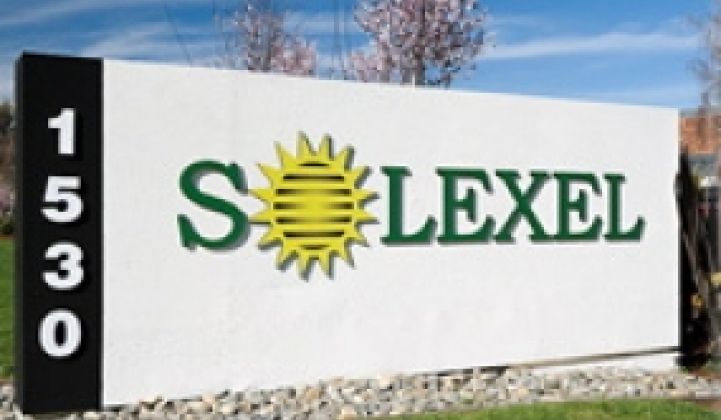Last week we reported on the $25 million investment in thin-silicon startup Solexel. This update serves to identify the new investors in the $25 million C round.
Gentry Venture Partners of Chicago led the round, according to a report in Bloomberg. Gentry has co-invested along with Kleiner Perkins on a number of other deals, including Fisker Automotive and Bloom Energy.
Perhaps more interesting: according to SEC filings, SunPower is also an investor in the round, through its internal venture capital arm. Doug Rose, senior director of technology strategy at SunPower is listed on the SEC document. Gentry and SunPower join Technology Partners and DAG Ventures in this round. SunPower has not yet responded to our request for comment on the investment.
The SunPower participation is notable because of the potential strategic value of Solexel to SunPower, as well as the strong due diligence expected from the c-Si efficiency leader in vetting this type of investment.
***
Original article follows:
Getting later-stage VC funding for a photovoltaic module company with an unproven technology can't be easy. It might barely make any sense to launch a startup in the current solar market, either.
But Solexel, a Milpitas, California-based solar firm still in stealth, just closed on a $25 million C round, according to an SEC filing.
The firm has raised funding from Kleiner Perkins, Technology Partners, DAG Ventures, The Westly Group, EcoFin, Spirox, Oakhill, Univest, and Northgate Capital, closing a $15 million A round in 2007, an undisclosed B round in 2008, and some additional funding from The Westly Group in 2010. The company looks to have more than 100 employees. The CFO, Jonathan Michael, is the former CFO of Solyndra.
The firm also received a $13 million Sunshot grant in its Extreme Balance of System Hardware Cost Reductions section, along with partner Owens Corning, to "develop a building-integrated PV roofing shingle and installation accessories for residential sloped-roof applications."
Solexel received about $3 million in DOE incubator money in late 2008 with this description:
Solexel plans on commercializing a disruptive, 3D, high-efficiency mono-crystalline silicon cell technology, while dramatically reducing manufacturing cost per watt. At the end of this project, Solexel plans to deliver a 17-percent to 19-percent efficient, 156x156 mm2, single-crystal cell that consumes substantially less silicon per watt than conventionally sliced wafers.
In any case, it seems that Solexel falls in the very-thin-silicon, kerfless-wafer school along with Twin Creeks, AstroWatt, SiGen, Crystal Solar and 1366.
Last August, we reported that Solexel, the former Soltaix, was scouting out manufacturing sites in Malaysia's Senai Hi-Tech Park to build a multi-gigawatt-capacity photovoltaic cell manufacturing plant. The company will be in the business of building solar modules, according to a conversation with Ryan Brown, Director of Corporate Development at Solexel, in an otherwise uninformative phone interview.
The firm's LinkedIn blurb says its "approach is based on a disruptive, IP-protected, high-efficiency technology which reduces silicon consumption by a significant margin compared to the current paradigm and substantially eliminates dependency on the silicon feedstock, ingot, and wafer supply chain. Active cell area is made through the use of plentiful, inexpensive silicon gas, as opposed to costly bulk silicon wafers."
Judging by the NREL disclosures and patent information, Solexel is or was also working on an epitaxial lift-off scheme using Porous-Silicon-Process (PSI process) technology licensed from the Max Planck Society, as well as some 3D wafer features, including prisms and a "honeycomb" array.
Here's the patent for three-dimensional solar cells with honeycomb prisms. Here's a patent for manufacturing three-dimensional thin film silicon solar cells. And here's a patent for releasing a thin film substrate from a reusable semiconductor template. Here are links to some other Solexel patents. Most of the patents are invented by Mehrdad Moslehi, the founder and CTO of the firm.
One of Greentech Media's solar analysts was able to determine this about the firm: "They are similar to Crystal Solar in that they are depositing crystalline silicon via the gas phase onto a reusable substrate with a release layer (probably porous silicon)" but Solexel is "trying to save the cost of texturing by growing the light trapping texture into the "wafer" itself by having a substrate with a pyramid-like surface topography."
When Solexel was formed, solar modules were selling in the neighborhood of $4.50 per watt. Today you can buy a reputable brand's module for less than $1.00 per watt.
This is the new solar landscape that Solexel is going to have to play in -- a landscape the firm and its investors might not have imagined when it was first formed.



